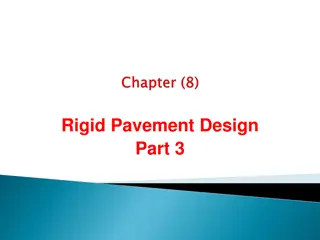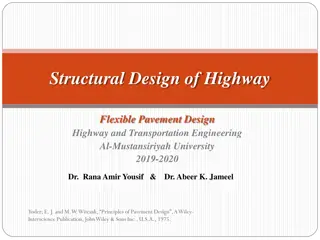AASHTOWarePMED UserGroup Design Challenge #2 Instructions
Instructions for Design Challenge #2 include gathering into assigned groups, opening PMED 3.xx web application for analysis, selecting templates, working on layer thicknesses and material types, inputting traffic and climate data, and selecting design properties for jointed and continuously reinforc
6 views • 15 slides
Rigid Pavement Design: Stresses and Joint Types
Stresses due to temperature variation can affect concrete slabs, causing warping and friction stresses. Proper joint design, including expansion, contraction, and construction joints, is crucial to minimize stress and prevent warping in concrete pavements. This guide explores different types of join
4 views • 9 slides
AASHTO Method for Determining Effective Roadbed Soil Resilient Modulus
The AASHTO method provides a systematic approach for evaluating the effective roadbed soil resilient modulus in flexible pavements. It involves calculating the relative damage to pavements based on predicted traffic load and allowable load repetitions. The method considers the seasonal moduli values
0 views • 30 slides
Guidelines for Design of Cement Concrete Pavement and Interlocking Paver Blocks
This document provides guidelines for designing cement concrete pavements and interlocking paver blocks, covering factors governing design, wheel loads, design period, subgrade characteristics, approximate k values based on CBR values, and the importance of a sub-base below concrete pavements. It em
0 views • 67 slides
Importance of Regular Parking Lot Sweeping in Property Maintenance
Regularly sweeping parking lots is crucial for asset management, risk reduction, environmental compliance, and aesthetics. Sweeping helps prevent wear and tear on pavements, extends the life of sealcoat and striping, reduces liability risks, manages stormwater efficiently, and controls rodent infest
0 views • 6 slides
AASHTO Pavements Working Group Meeting Overview
The AASHTO Pavements Working Group meeting from July 18, 2011, covered various topics including self-introductions, research updates, NCHRP and TRB updates, FHWA Transportation System Preservation Roadmap, and SCOM vision and mission. Discussions were held on membership details, meeting locations, a
0 views • 22 slides
- "Development of Pavement-Specific Structural Synthetic Fibers - TAP Meeting Insights
- The TAP meeting on the development of pavement-specific structural synthetic fibers held on November 3, 2021, highlighted key benefits of fibers in pavements, such as increased load transfer efficiency and reduced cracking. Various industry partners and experts discussed the participation of fiber
0 views • 42 slides
2018 Maintenance Update: Snow & Ice Management and Pavements Maintenance
The 2018 maintenance update includes discussions on snow and ice management issues such as salt usage, contract truck problems, vendor salt deliveries, cave salt deliveries, and available dashboards for data monitoring. Additionally, preventive maintenance programs related to pavements have seen sig
0 views • 14 slides
Pavement Engineering Overview: Types, Design, and Requirements
A comprehensive overview of highway pavement engineering, covering types of pavements, structural requirements, ideal pavement characteristics, and classifications into flexible, rigid, and composite pavements. Proper pavement design is crucial for ensuring long-lasting, safe, and high-quality road
0 views • 19 slides
Introduction to Rigid Pavement Design in Highway Engineering
Rigid pavements, made of cement or reinforced concrete slabs, are designed to resist traffic loads by distributing them over a wide area of soil. The design focuses on providing a structurally strong concrete slab. Minor variations in subgrade strength have little impact on rigid pavement capacity,
0 views • 13 slides
Effective Pavement Management Program Overview
This program by the Pennsylvania Department of Transportation focuses on the importance of implementing preventive maintenance strategies at the right time for highway pavement management. It covers topics such as types of pavements, preventive maintenance concepts, treatment selection, and timing f
0 views • 14 slides
Climate Models and Moisture Equilibrium in Flexible Pavement Design
Climate inputs like temperature and moisture play key roles in flexible pavement design. The heat transfer model evaluates frost action and temperature regimes, while moisture equilibrium models consider the interaction between soil suction and moisture content. Understanding these factors is crucia
0 views • 13 slides
Re-Alignment of US 17 in Zolfo Springs with Concrete Pavements Project Overview
The project involves realigning a segment of US 17 in Zolfo Springs, Florida, improving corridor safety and infrastructure. Contractor Ajax Paving Industries will construct a concrete roadway with bike lanes, sidewalks, and stormwater management systems. The old US 17 will become Main Street for Zol
0 views • 28 slides
Truck Size and Weight Impacts on Highways
The presentation delves into the interdependent aspects of truck weight - axle weight and Gross Vehicle Weight (GVW) - on highway infrastructure, emphasizing their impacts on pavements and bridges. It also discusses industry challenges related to Truck Size and Weight (TS&W) limits and their effects
0 views • 38 slides
Overview of Fine Milling in Road Maintenance
Fine milling, led by Josh Hornbeck, is a critical process in road maintenance aimed at removing deteriorated pavement, maintaining elevation, keying into existing pavement structures, and improving skid numbers. This involves texture adjustment, profile enhancement, and removal of rutting to ensure
2 views • 25 slides
MAP-21 Performance Measures for Pavements and Bridges Overview
MAP-21, a federal transportation funding bill, established a performance-based program focusing on national transportation goals to increase accountability and transparency. The program emphasizes key areas such as safety, infrastructure condition, congestion reduction, system reliability, freight m
0 views • 23 slides
2013 Construction & Material Specifications Training Overview
This document provides an overview of the training session conducted for the 2013 Construction and Material Specifications. It covers the significant changes introduced, the publication dates of associated documents, key topics discussed in the training sessions, conversion guidelines, and the sched
0 views • 7 slides
















